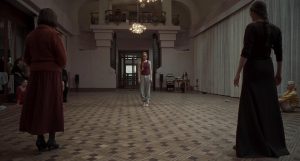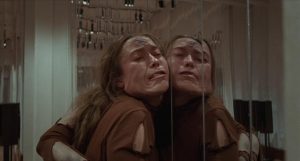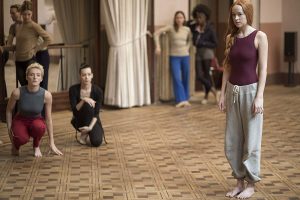![]()
Just in time for Halloween, this week sees the release of Suspiria, a very loose remake of the surreal 1977 Dario Argento horror classic. If you’re expecting thrills and chills, this adaptation will probably leave something to be desired. This is a completely different beast; it’s a cold, gray film that tries to make a few comments about female empowerment (at least, I think it does) among its supernatural turns. But do the alterations result in a new and dynamic feature?
 Set during the Cold War of the late 1970s, this tale takes place in a gloomy Berlin that is split between American and Russian forces. Specifically, it takes place at a prestigious dance academy in West Berlin. New American student Susie Bannion (Dakota Johnson) arrives after the strange disappearance of star pupil Patricia (Chloe Grace Moretz). The eerie environment doesn’t seem to bother Susie very much, as she immediately impresses institute director Madam Blanc (Tilda Swinton). After a series of increasingly disturbing events, many figures inside and out of the academy begin to suspect that the academy may be run by a coven of witches.
Set during the Cold War of the late 1970s, this tale takes place in a gloomy Berlin that is split between American and Russian forces. Specifically, it takes place at a prestigious dance academy in West Berlin. New American student Susie Bannion (Dakota Johnson) arrives after the strange disappearance of star pupil Patricia (Chloe Grace Moretz). The eerie environment doesn’t seem to bother Susie very much, as she immediately impresses institute director Madam Blanc (Tilda Swinton). After a series of increasingly disturbing events, many figures inside and out of the academy begin to suspect that the academy may be run by a coven of witches.
 As mentioned, the tone is completely different. The subdued color palette is also complete reversal from the original, but there are a few visually interesting shots. There’s an impressive master that wanders around the teacher’s lounge for several minutes as the group discusses their plans for the students. And there is one disturbing, chilling sequence involving a dancer performing and twisting herself around like a pretzel that is effectively unsettling. Every so often, there’s an odd and disturbing moment like this that raises interest.
As mentioned, the tone is completely different. The subdued color palette is also complete reversal from the original, but there are a few visually interesting shots. There’s an impressive master that wanders around the teacher’s lounge for several minutes as the group discusses their plans for the students. And there is one disturbing, chilling sequence involving a dancer performing and twisting herself around like a pretzel that is effectively unsettling. Every so often, there’s an odd and disturbing moment like this that raises interest.
It seems clear that director Luca Guadagnino (Call Me by Your Name) is attempting to expand and expound on thematic elements. The matriarchy here is a powerful force not be stopped in their pursuits. In fact, they even do horrific and inhuman things to each other. There are critical comments made about Patricia’s male psychotherapist (believe it or not, also played by Swinton) not believing her accusations early on. It’s a curious point, although one instantly thinks that claims of a supernatural force out to take over the world via influence and satanic rituals would raise disbelief from anyone regardless of gender. And heck, one could make a claim that Bannion’s character may be standing in for America in general and its actions abroad. Who knows? It’s all interesting to ponder, if a little jumbled.
 Personally, I think my own issues with the film revolve around the pacing and approach to delivering exposition and plot detail. This is an almost ridiculously lengthy movie, running at over two hours and thirty minutes. To maintain interest, one would think that it needs to keep viewers engaged by slowly releasing details and allowing them to try and figure out what is going on. However, the script chooses to bluntly spell everything out.
Personally, I think my own issues with the film revolve around the pacing and approach to delivering exposition and plot detail. This is an almost ridiculously lengthy movie, running at over two hours and thirty minutes. To maintain interest, one would think that it needs to keep viewers engaged by slowly releasing details and allowing them to try and figure out what is going on. However, the script chooses to bluntly spell everything out.
 Perhaps the whole approach was to exemplify the sometimes mundane nature of evil, but there is something to be said for releasing information in a careful, judicious manner to generate intrigue and suspense. These witches act like malevolent beings pretty quickly and then the characters literally tell you their plans; viewers are left to simply wait for it all to happen. As a result, there are a couple of emotional beats late in the film that should have had a much bigger impact. However, the fact that important details are given up much earlier in the film draws away any sort of tension, shock and devastation from the reveal. What is about to happen is never in doubt. The only thing left to ponder is the deeper meaning intended.
Perhaps the whole approach was to exemplify the sometimes mundane nature of evil, but there is something to be said for releasing information in a careful, judicious manner to generate intrigue and suspense. These witches act like malevolent beings pretty quickly and then the characters literally tell you their plans; viewers are left to simply wait for it all to happen. As a result, there are a couple of emotional beats late in the film that should have had a much bigger impact. However, the fact that important details are given up much earlier in the film draws away any sort of tension, shock and devastation from the reveal. What is about to happen is never in doubt. The only thing left to ponder is the deeper meaning intended.
In the end, Suspiria is a completely unique take on the original film and one that does include several intriguing elements. Yet I found myself only marginally engrossed by what I was witnessing. It’s an intellectual exercise that doesn’t trigger much of an emotional response or (besides a couple of moments mentioned earlier in the review) any sort of chills or excitement. Again, this may have been the intent, but it does leave one feeling slightly underwhelmed. Call me a simpleton, but I’ll still take the Grimms’-Fairy-Tale-for-adults oddball charm of the original any day.


